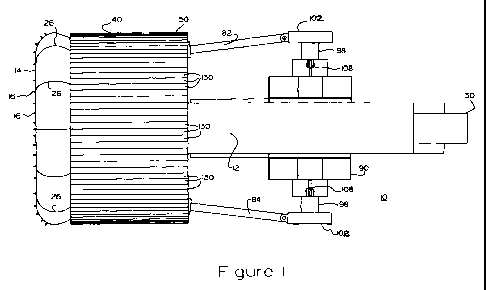Some of the information on this Web page has been provided by external sources. The Government of Canada is not responsible for the accuracy, reliability or currency of the information supplied by external sources. Users wishing to rely upon this information should consult directly with the source of the information. Content provided by external sources is not subject to official languages, privacy and accessibility requirements.
Any discrepancies in the text and image of the Claims and Abstract are due to differing posting times. Text of the Claims and Abstract are posted:
| (12) Patent Application: | (11) CA 2774492 |
|---|---|
| (54) English Title: | MODIFICATION TO A TBM STRUCTURE TO PROVIDE ROOF SUPPORT INSTALLATION |
| (54) French Title: | MODIFICATION APPORTEE A UNE STRUCTURE DE TUNNELIER POUR REALISER UNE INSTALLATION DE SUPPORT DE TOIT |
| Status: | Deemed Abandoned and Beyond the Period of Reinstatement - Pending Response to Notice of Disregarded Communication |
| (51) International Patent Classification (IPC): |
|
|---|---|
| (72) Inventors : |
|
| (73) Owners : |
|
| (71) Applicants : |
|
| (74) Agent: | EDWARD H. OLDHAMOLDHAM, EDWARD H. |
| (74) Associate agent: | |
| (45) Issued: | |
| (86) PCT Filing Date: | 2009-01-30 |
| (87) Open to Public Inspection: | 2010-01-14 |
| Availability of licence: | N/A |
| Dedicated to the Public: | N/A |
| (25) Language of filing: | English |
| Patent Cooperation Treaty (PCT): | Yes |
|---|---|
| (86) PCT Filing Number: | PCT/CA2009/000107 |
| (87) International Publication Number: | WO 2010003213 |
| (85) National Entry: | 2012-04-23 |
| (30) Application Priority Data: | ||||||
|---|---|---|---|---|---|---|
|
A TBM having a cylindrically shaped member located on said TBM just behind the rotating boring head, said member being of similar diameter as said tunnel and comprising sectionalized components so as to be adjustable in diameter, said member having a plurality of steel angle members welded to the surface of the top-most component so as to extend axially along the length of said cylindrically shaped member, said steel angle members forming axially extending receptacles therein.
L'invention porte sur un tunnelier comportant un élément de forme cylindrique situé sur ledit tunnelier juste derrière la tête de forage rotative, ledit élément ayant un diamètre similaire à celui dudit tunnel, et comprenant des composants en section afin d'avoir un diamètre réglable, ledit élément comportant une pluralité d'éléments de cornières en acier soudés à la surface du composant supérieur de façon à s'étendre axialement le long de la longueur dudit élément de forme cylindrique, lesdits éléments de cornières en acier formant des réceptacles s'étendant axialement à l'intérieur de ceux-ci.
Note: Claims are shown in the official language in which they were submitted.
Note: Descriptions are shown in the official language in which they were submitted.

2024-08-01:As part of the Next Generation Patents (NGP) transition, the Canadian Patents Database (CPD) now contains a more detailed Event History, which replicates the Event Log of our new back-office solution.
Please note that "Inactive:" events refers to events no longer in use in our new back-office solution.
For a clearer understanding of the status of the application/patent presented on this page, the site Disclaimer , as well as the definitions for Patent , Event History , Maintenance Fee and Payment History should be consulted.
| Description | Date |
|---|---|
| Application Not Reinstated by Deadline | 2015-01-30 |
| Time Limit for Reversal Expired | 2015-01-30 |
| Inactive: Abandon-RFE+Late fee unpaid-Correspondence sent | 2014-01-30 |
| Deemed Abandoned - Failure to Respond to Maintenance Fee Notice | 2014-01-30 |
| Inactive: Cover page published | 2012-06-06 |
| Correct Applicant Requirements Determined Compliant | 2012-05-03 |
| Inactive: Inventor deleted | 2012-05-03 |
| Inactive: Notice - National entry - No RFE | 2012-05-03 |
| Correct Applicant Requirements Determined Compliant | 2012-05-02 |
| Application Received - PCT | 2012-05-02 |
| Inactive: First IPC assigned | 2012-05-02 |
| Inactive: IPC assigned | 2012-05-02 |
| Inactive: IPC assigned | 2012-05-02 |
| Inactive: IPC assigned | 2012-05-02 |
| National Entry Requirements Determined Compliant | 2012-04-23 |
| Application Published (Open to Public Inspection) | 2010-01-14 |
| Abandonment Date | Reason | Reinstatement Date |
|---|---|---|
| 2014-01-30 |
The last payment was received on 2012-04-23
Note : If the full payment has not been received on or before the date indicated, a further fee may be required which may be one of the following
Please refer to the CIPO Patent Fees web page to see all current fee amounts.
| Fee Type | Anniversary Year | Due Date | Paid Date |
|---|---|---|---|
| Basic national fee - standard | 2011-12-23 | ||
| Reinstatement (national entry) | 2011-12-30 | ||
| MF (application, 2nd anniv.) - standard | 02 | 2011-01-31 | 2012-03-08 |
| MF (application, 4th anniv.) - standard | 04 | 2013-01-30 | 2012-04-23 |
| MF (application, 3rd anniv.) - standard | 03 | 2012-01-30 | 2012-04-23 |
Note: Records showing the ownership history in alphabetical order.
| Current Owners on Record |
|---|
| MICHAEL P. MCNALLY |
| Past Owners on Record |
|---|
| None |